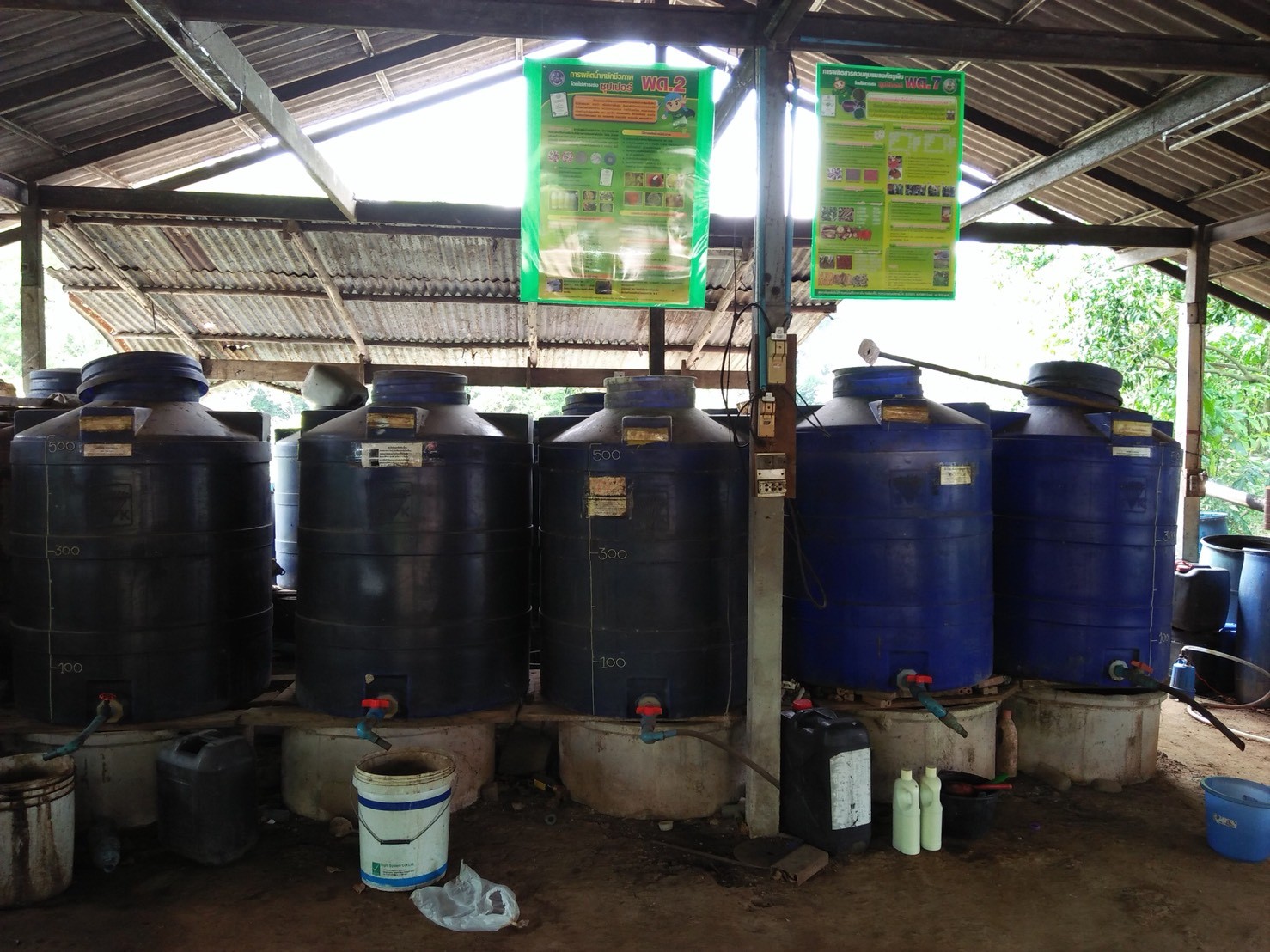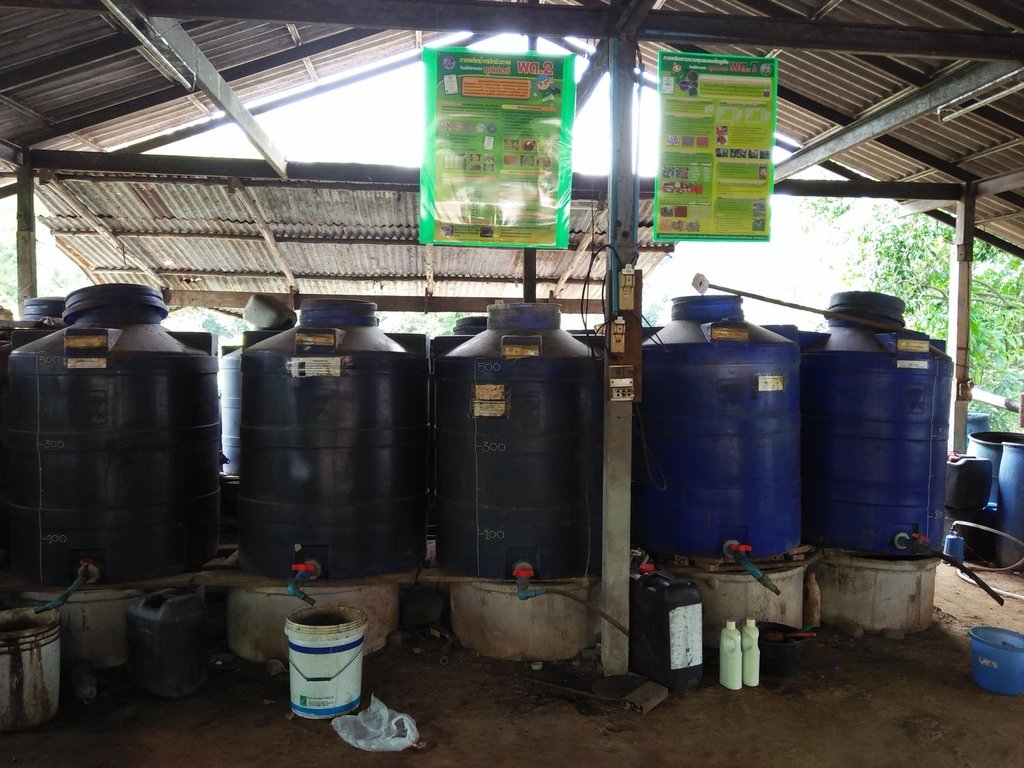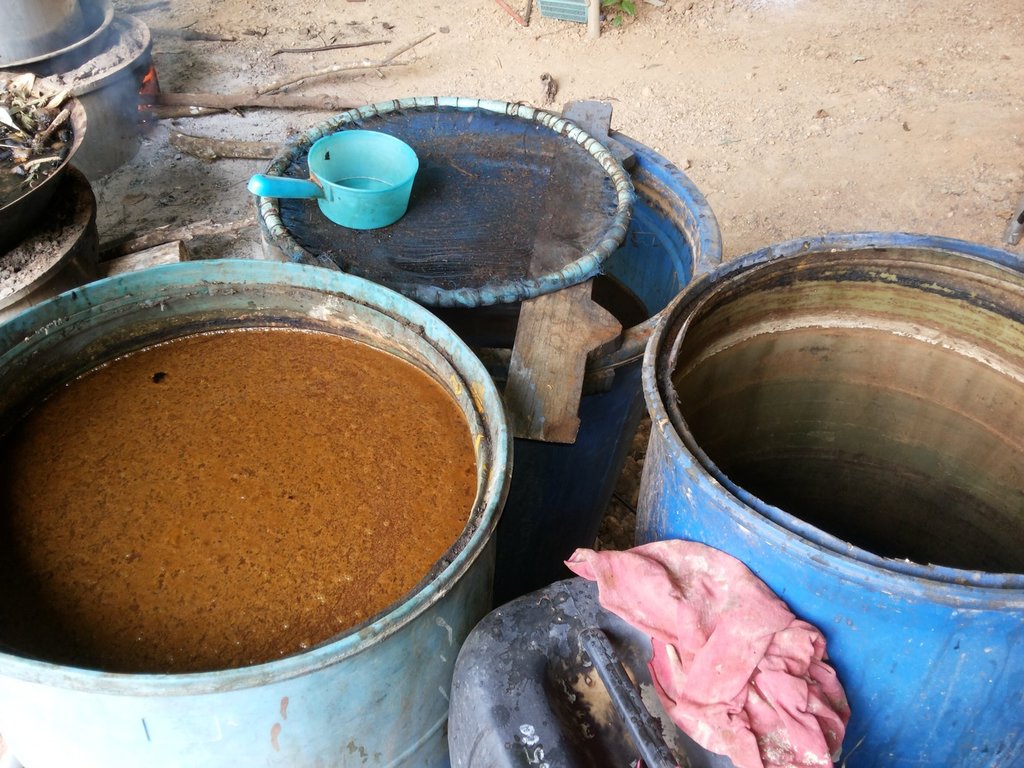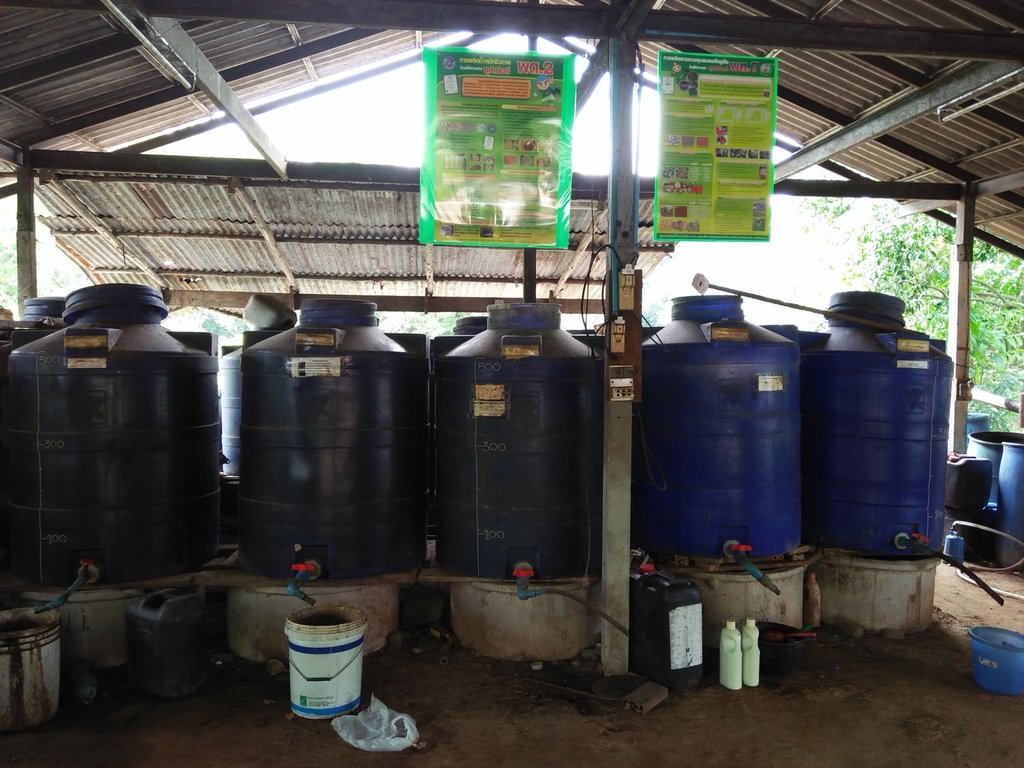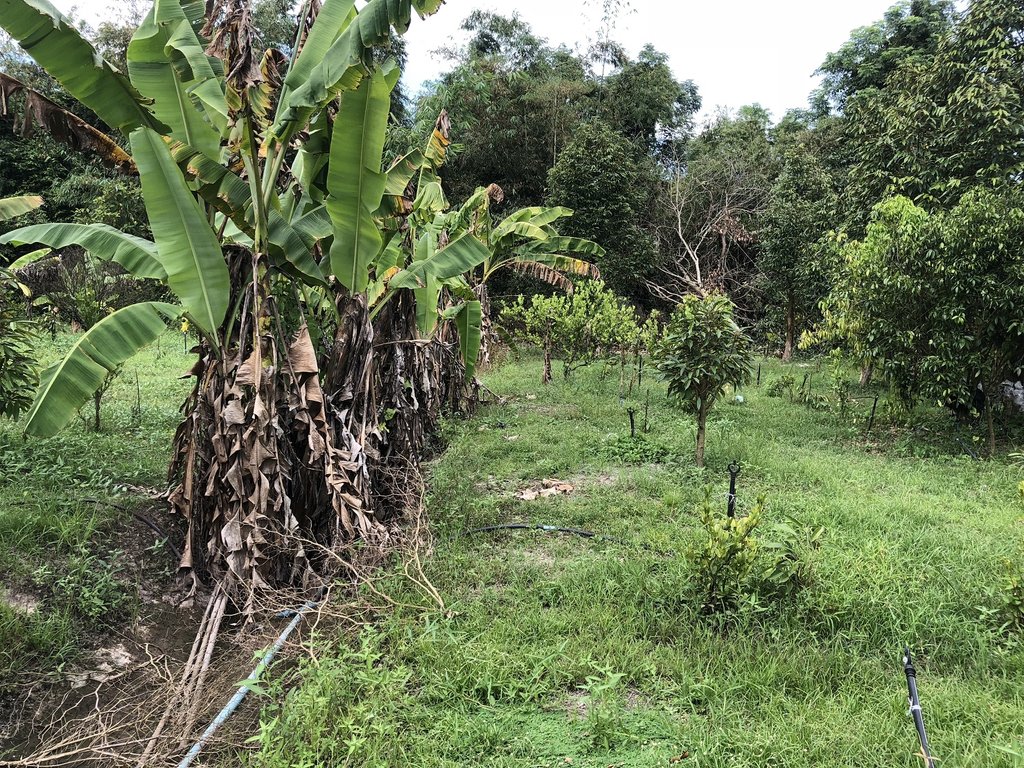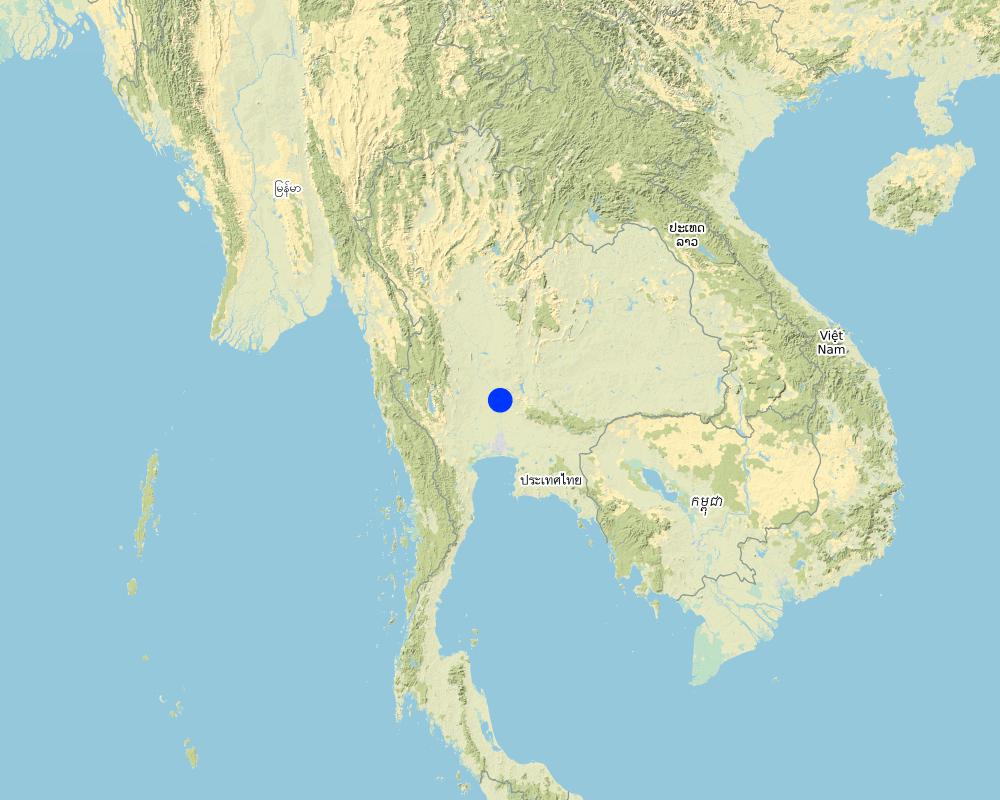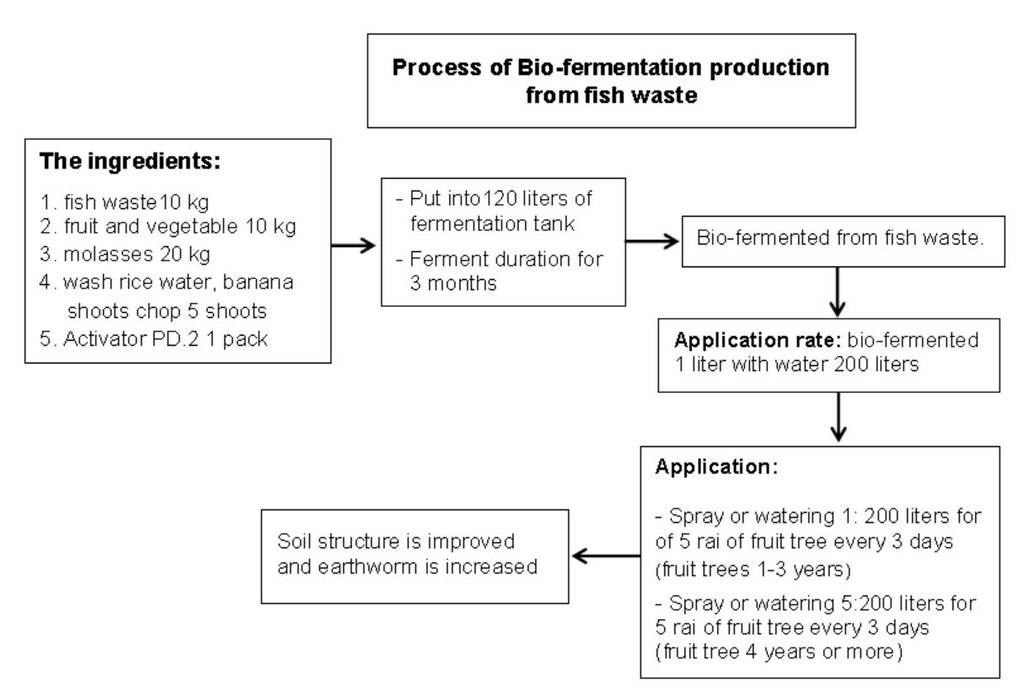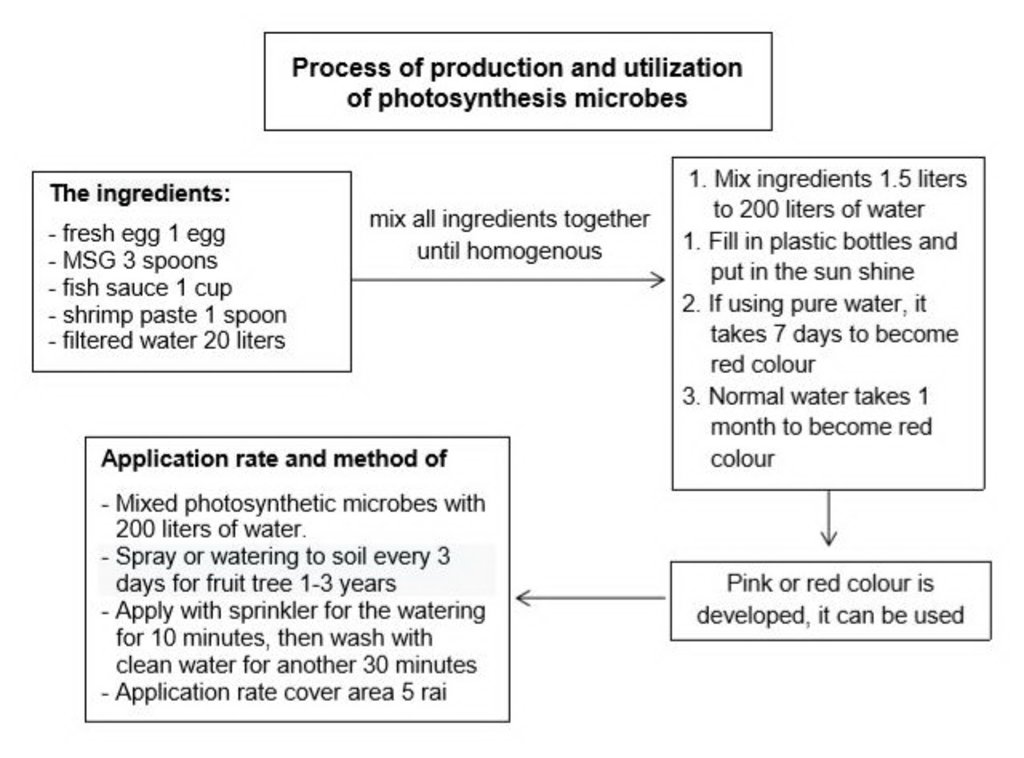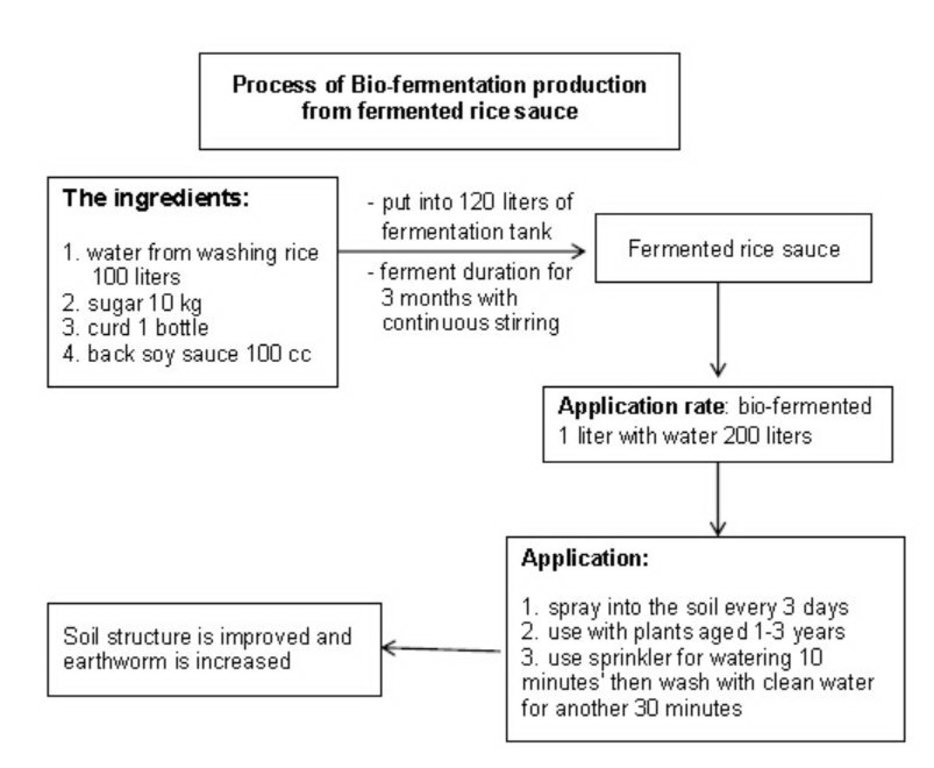Bio-fermentation for Soil Improvement (Thailand)
- Creation:
- Update:
- Compiler: Kukiat SOITONG
- Editor: –
- Reviewers: Rima Mekdaschi Studer, William Critchley
Num Mak Che Wa Parp
technologies_4233
View sections
Expand all Collapse all1. General information
1.2 Contact details of resource persons and institutions involved in the assessment and documentation of the Technology
Key resource person(s)
SLM specialist:
ผู้รวบรวม:
Durongkarn Saroj
Prachinburi Land Development Station Land Development
Thailand
land user:
Sonloy Wanpen
Soil Doctor
Thailand
SLM specialist:
Hawasuwan Narumon
Regional 2 Land Development Office ,Land development Department
Thailand
SLM specialist:
Sanguanrat Siriporn
Regional 2 Land Development Office ,Land development Department
Thailand
1.3 Conditions regarding the use of data documented through WOCAT
The compiler and key resource person(s) accept the conditions regarding the use of data documented through WOCAT:
Yes
1.4 Declaration on sustainability of the described Technology
Is the Technology described here problematic with regard to land degradation, so that it cannot be declared a sustainable land management technology?
No
Comments:
This technology be applied in sandy soil areas
2. Description of the SLM Technology
2.1 Short description of the Technology
Definition of the Technology:
Bio-fermentation for the production of organic soil amendments is an alternative technology that helps restore degraded land caused by intensive use and return it to a fertility level that can produce crops effectively.
2.2 Detailed description of the Technology
Description:
Bio-fermentation for the production of organic soil improvement amendments is an alternative technology that helps restore degraded land caused by intensive use and return it to a fertility level that can produce crops effectively. A study was carried out in Prachinburi Province, Thailand, where there are chemical and physical degradation problems on the land. The area is lowland, with very sandy soil. The soil structure is poor and drainage is very slow. The organic matter and plant nutrient contents and soil fertility are low. Rice is grown but it gives very low yields. Farmers have changed their rice fields to orchards and grow fruit and other edible crops such as durian, banana, lemon, vegetables (including Acacia pennata – Cha-om). They developed the land by digging ditches to make 1m-wide beds for growing crops and 0.8m-wide x 0.8m-deep drainage ditches. Farmers apply high rates of chemicals for both pest/weed control and fertilizers, continuously. This is the main reason why farmers find the productivity of their land decreasing, caused by chemical soil degradation, and their farm investment has become unprofitable.
Organic agriculture has been found to be their solution. Farmers have learnt to develop their own bio-fermentation technology to produce organic fertilizers for soil improvement. There are three types of biological fermentation: (1) production of bio-fermented solution from discarded fish by-products by using microbial activators, (2) production of photosynthetic microorganisms, and (3) production of bio-fermented water from rice flour water. They use the three types of bio-fermentation products to improve the soil by mixing at a rate of 1:1:1 per 200 L of water and applying to the soil during the first 3 years of fruit-tree planting. The use of bio-fermentation to improve the soil involves a number of important activities: one is the process to produce bio-fermented solutions and the other is how to apply such solutions.
The impacts of the technology that the farmers have found are that it makes the soil more fertile, and organic matter and microorganisms in the soil (incl. earthworms) increase. The benefits from nutrients in the soil increase, as durian saplings can be grown which can be sold at a high price (e.g. 180 THB/sapling). The cost of the technology is low because the farm’s waste materials are used. The farmers’ income increases; farmers enjoy better life with no debts – they are self-reliant as they are using environmentally friendly technology. There are reasons why farmers like this technology. This technology comprises the knowledge derived from experiential/ practical experiments in the area of farmer-prototype technology users who can see the real results from using it. The methods/procedures are not complicated; it is therefore easy to use. The technology is available through many channels, so farmers can access it easily. But there are some reasons why farmers still do not agree with this technology, i.e. there have been no technical documents with analytical data of plant nutrients or other effective ingredients to support it. Other farmers generally lack the motivation to adopt the technology.
2.3 Photos of the Technology
2.4 Videos of the Technology
Comments, short description:
การใช้เทคโนโลยีชีวภาพเพื่อการพัฒนาที่ดิน
Date:
07/03/2018
Name of videographer:
LDD
2.5 Country/ region/ locations where the Technology has been applied and which are covered by this assessment
Region/ State/ Province:
Eastern region
Further specification of location:
62/1 Moo5 Maiket Sub-district, Muang District, Prachinburi Province 25230, Thailand
Map
×2.6 Date of implementation
Indicate year of implementation:
1997
If precise year is not known, indicate approximate date:
- 10-50 years ago
2.7 Introduction of the Technology
Specify how the Technology was introduced:
- through land users' innovation
3. Classification of the SLM Technology
3.1 Main purpose(s) of the Technology
- improve production
- reduce, prevent, restore land degradation
- conserve ecosystem
- preserve/ improve biodiversity
3.2 Current land use type(s) where the Technology is applied

Cropland
- Tree and shrub cropping
- mixed crop
Number of growing seasons per year:
- 2
Specify:
-
Comments:
-
3.3 Has land use changed due to the implementation of the Technology?
Comments:
-
3.4 Water supply
Water supply for the land on which the Technology is applied:
- rainfed
Comments:
-
3.5 SLM group to which the Technology belongs
- integrated soil fertility management
- integrated pest and disease management (incl. organic agriculture)
3.6 SLM measures comprising the Technology

other measures
Specify:
Produce and use bio-fermentation solution.
Comments:
Integrated farming with both fruit trees and vegetables
3.7 Main types of land degradation addressed by the Technology

chemical soil deterioration
- Cn: fertility decline and reduced organic matter content (not caused by erosion)

physical soil deterioration
- Pc: compaction

biological degradation
- Bl: loss of soil life
Comments:
Overuse of chemical fertilizer
3.8 Prevention, reduction, or restoration of land degradation
Specify the goal of the Technology with regard to land degradation:
- reduce land degradation
- restore/ rehabilitate severely degraded land
Comments:
Many years of overuse of chemical fertilizer
4. Technical specifications, implementation activities, inputs, and costs
4.1 Technical drawing of the Technology
Technical specifications (related to technical drawing):
The methodology to produce the three types bio-fermented solution are as follow:
1. Production of bio-fermented solution from the discarded fish parts by using the ‘LDD Microbial Activator number 2’, by using 10 kg discarded fish parts, 10 kg fruit and vegetable mixture, 20 kg molasses, the water from washing rice or the banana fraction 5 stems and 1 pack of the LDD Microbial Activator number LDD 1, then mix everything in a 120L tank and let it stay for 3 months.
Author:
Saroj Durongkarn
Date:
02/10/2018
Technical specifications (related to technical drawing):
2. Production of photosynthetic microorganisms is made by mixing 5 eggs, 3 tablespoons of mono-sodium glutamate (MSG), 1 tablespoon of fish sauce, 1 tablespoon of filtered water and 20 L of pure water in a homogeneous mixture at a rate of 1.5 L per 200 L of water, when it will be red within 7 days (in case of using pure water) and within 1 month (in case of using clear water).
Author:
Saroj Durongkarn
Date:
02/10/2018
Technical specifications (related to technical drawing):
3. Production of bio-fermented solution by mixing 100 L of rice flour water, 10 kg of sugar, 1 bottle of Yakult (curd) and 10 ml of fermented soy sauce in a 120L fermentation tank for 3 months.
The bio-fermented solution to improve the soil can be applied at different stages of crops/trees.
At the early stage before the production period (1-3 years) use 20 LT of the mixture of three types of bio-fermented solution at a rate of 1:1:1 per 200 L of water and spray or pour on the ground every 3 days or use sprinkler system to deliver the bio-fermented water for 10 minutes, followed with the clear water for 30 minutes.
At the fruiting stage (more than 4 years) dilute 5 L of the bio-fermented solution from discarded fish parts with 200 L of water and spray or pour on the ground every 3 days or use sprinkler system to deliver the bio-fermented solution for 10 minutes, followed with the clear water for 30 minutes.
Author:
saroj durongkarn
Date:
02/10/2018
Technical specifications (related to technical drawing):
Production of photosynthetic microorganisms made by 5 eggs, 3 tablespoons of MSG, 1 tablespoon of fish sauce, 1 tablespoon of filtered water and 20 liters of pure water mixed in a homogeneous mixture at the rate of 1.5 liters per 200 liters of water for 7 days and it will be red (in case of using the pure water) and 1 month (in case of using clear water).
Production of bio-fermented solution from using 100 liter of rice flour water, 10 kilogram of sugar, 1 yakult bottle (curd) and 10 milliliters of fermented soy sauce in a 120 liters pot size fermentation tank for 3 months
Author:
Saroj Durongkarn
4.2 General information regarding the calculation of inputs and costs
Specify how costs and inputs were calculated:
- per Technology area
Indicate size and area unit:
1 rai
If using a local area unit, indicate conversion factor to one hectare (e.g. 1 ha = 2.47 acres): 1 ha =:
6.25 rai
other/ national currency (specify):
THB
If relevant, indicate exchange rate from USD to local currency (e.g. 1 USD = 79.9 Brazilian Real): 1 USD =:
32.0
Indicate average wage cost of hired labour per day:
300 baht
4.3 Establishment activities
| Activity | Timing (season) | |
|---|---|---|
| 1. | The production process | before and in between growing period |
| 2. | The using steps of bio-fermented solution | before and in between growing period |
Comments:
the use of technology before harvesting period
4.4 Costs and inputs needed for establishment
| Specify input | Unit | Quantity | Costs per Unit | Total costs per input | % of costs borne by land users | |
|---|---|---|---|---|---|---|
| Labour | labor for bio fermentation solution production | Person | 2.0 | 300.0 | 600.0 | 100.0 |
| Labour | labor for pipe sprinkler /fertigation system | Person | 2.0 | 300.0 | 600.0 | 100.0 |
| Equipment | pipe and irrigation system | Clas | 50.0 | 40.0 | 2000.0 | 100.0 |
| Equipment | water pumping machine | Pump | 1.0 | 8000.0 | 8000.0 | 100.0 |
| Fertilizers and biocides | fermentation tank | pc | 3.0 | 500.0 | 1500.0 | 80.0 |
| Fertilizers and biocides | molasses | litre | 120.0 | 12.0 | 1440.0 | 80.0 |
| Fertilizers and biocides | fish fraction /fruit and vegetable fraction/Waste | kg | 40.0 | 10.0 | 400.0 | 100.0 |
| Fertilizers and biocides | eggs,MSG,shrimp paste /Yakult/sugar | - | 1.0 | 100.0 | 100.0 | 100.0 |
| Fertilizers and biocides | LDDื ืno.2 innoculant | pc | 1.0 | 14.0 | 14.0 | 100.0 |
| Total costs for establishment of the Technology | 14654.0 | |||||
| Total costs for establishment of the Technology in USD | 457.94 | |||||
If land user bore less than 100% of costs, indicate who covered the remaining costs:
Prachinburi Land development Station
Comments:
LD station supported the bio fermented solution production inputs as tank ,molasses and microorganism
4.5 Maintenance/ recurrent activities
| Activity | Timing/ frequency | |
|---|---|---|
| 1. | The use of bio-fermented solution | once a week |
| 2. | The production process of bio-fermented solution | once in three months |
Comments:
maintenance the equipment
4.6 Costs and inputs needed for maintenance/ recurrent activities (per year)
| Specify input | Unit | Quantity | Costs per Unit | Total costs per input | % of costs borne by land users | |
|---|---|---|---|---|---|---|
| Labour | labor for bio fermentation solution production | man | 4.0 | 300.0 | 1200.0 | 100.0 |
| Equipment | irrigation system equipment | pc. | 50.0 | 40.0 | 2000.0 | 100.0 |
| Fertilizers and biocides | molasses | liter | 120.0 | 12.0 | 1440.0 | 80.0 |
| Fertilizers and biocides | fish fraction /fruit and vegetable fraction/Waste | kg | 40.0 | 10.0 | 400.0 | 100.0 |
| Fertilizers and biocides | eggs,MSG,shrimp paste /Yakult/sugar | kg | 1.0 | 100.0 | 100.0 | 100.0 |
| Fertilizers and biocides | LDDื ืno.2 innoculant | pc | 1.0 | 14.0 | 14.0 | |
| Total costs for maintenance of the Technology | 5154.0 | |||||
| Total costs for maintenance of the Technology in USD | 161.06 | |||||
If land user bore less than 100% of costs, indicate who covered the remaining costs:
-
Comments:
maintenance cost
4.7 Most important factors affecting the costs
Describe the most determinate factors affecting the costs:
Raw material of bio-fermentation solution products as molasses
5. Natural and human environment
5.1 Climate
Annual rainfall
- < 250 mm
- 251-500 mm
- 501-750 mm
- 751-1,000 mm
- 1,001-1,500 mm
- 1,501-2,000 mm
- 2,001-3,000 mm
- 3,001-4,000 mm
- > 4,000 mm
Specifications/ comments on rainfall:
-
Indicate the name of the reference meteorological station considered:
-
Agro-climatic zone
- humid
-
5.2 Topography
Slopes on average:
- flat (0-2%)
- gentle (3-5%)
- moderate (6-10%)
- rolling (11-15%)
- hilly (16-30%)
- steep (31-60%)
- very steep (>60%)
Landforms:
- plateau/plains
- ridges
- mountain slopes
- hill slopes
- footslopes
- valley floors
Altitudinal zone:
- 0-100 m a.s.l.
- 101-500 m a.s.l.
- 501-1,000 m a.s.l.
- 1,001-1,500 m a.s.l.
- 1,501-2,000 m a.s.l.
- 2,001-2,500 m a.s.l.
- 2,501-3,000 m a.s.l.
- 3,001-4,000 m a.s.l.
- > 4,000 m a.s.l.
Indicate if the Technology is specifically applied in:
- not relevant
Comments and further specifications on topography:
-
5.3 Soils
Soil depth on average:
- very shallow (0-20 cm)
- shallow (21-50 cm)
- moderately deep (51-80 cm)
- deep (81-120 cm)
- very deep (> 120 cm)
Soil texture (topsoil):
- coarse/ light (sandy)
Soil texture (> 20 cm below surface):
- coarse/ light (sandy)
Topsoil organic matter:
- low (<1%)
If available, attach full soil description or specify the available information, e.g. soil type, soil PH/ acidity, Cation Exchange Capacity, nitrogen, salinity etc.
-
5.4 Water availability and quality
Ground water table:
5-50 m
Availability of surface water:
medium
Water quality (untreated):
for agricultural use only (irrigation)
Is water salinity a problem?
No
Is flooding of the area occurring?
Yes
Comments and further specifications on water quality and quantity:
Water quality is suitable for agriculture but not good for household use
5.5 Biodiversity
Species diversity:
- high
Habitat diversity:
- medium
Comments and further specifications on biodiversity:
Broad number of crops and varieties such as durian, Longong, Pamelo Lemon Bean etc,
5.6 Characteristics of land users applying the Technology
Sedentary or nomadic:
- Sedentary
Market orientation of production system:
- mixed (subsistence/ commercial)
Off-farm income:
- less than 10% of all income
Relative level of wealth:
- rich
Individuals or groups:
- individual/ household
Level of mechanization:
- manual work
Gender:
- women
Age of land users:
- elderly
Indicate other relevant characteristics of the land users:
-
5.7 Average area of land used by land users applying the Technology
- < 0.5 ha
- 0.5-1 ha
- 1-2 ha
- 2-5 ha
- 5-15 ha
- 15-50 ha
- 50-100 ha
- 100-500 ha
- 500-1,000 ha
- 1,000-10,000 ha
- > 10,000 ha
Is this considered small-, medium- or large-scale (referring to local context)?
- medium-scale
Comments:
เนื่องจากเป็นการประเมินราคาที่ดินในเขตเมือง
5.8 Land ownership, land use rights, and water use rights
Land ownership:
- individual, titled
Land use rights:
- individual
Water use rights:
- open access (unorganized)
Specify:
สิทธิในการใช้น้ำเป็นแบบเปิดเนื่องจากเป็นประปาของชุมชนไม่มีระเบียบว่าอย่างไรแต่เสียค่าใช้จ่ายตามปริมาณใช้จริงและส่วนใหญ่การใช้น้ำในพื้นที่มาจากบ่อของตนเองเป็นหลัก
5.9 Access to services and infrastructure
health:
- poor
- moderate
- good
education:
- poor
- moderate
- good
technical assistance:
- poor
- moderate
- good
employment (e.g. off-farm):
- poor
- moderate
- good
markets:
- poor
- moderate
- good
energy:
- poor
- moderate
- good
roads and transport:
- poor
- moderate
- good
drinking water and sanitation:
- poor
- moderate
- good
financial services:
- poor
- moderate
- good
Comments:
-
6. Impacts and concluding statements
6.1 On-site impacts the Technology has shown
Socio-economic impacts
Production
crop production
Quantity before SLM:
10
Quantity after SLM:
30
Comments/ specify:
The number of durian fruits increases
crop quality
Comments/ specify:
Some inputs could not be used in the next year such as the fermentation tank
Income and costs
expenses on agricultural inputs
Comments/ specify:
some inputs could not use in the next year such as tank
farm income
Comments/ specify:
Seedling income increases
Socio-cultural impacts
food security/ self-sufficiency
Comments/ specify:
better, self-sufficient
health situation
land use/ water rights
community institutions
Comments/ specify:
family life is better
SLM/ land degradation knowledge
Comments/ specify:
Highly improved
Ecological impacts
Water cycle/ runoff
water quality
Comments/ specify:
Reduced contamination due to the use of organic substances, and the use of chemicals is much decreased
surface runoff
groundwater table/ aquifer
Soil
soil moisture
soil cover
Comments/ specify:
grass cover/ earthworms
soil loss
soil crusting/ sealing
Comments/ specify:
better soil, become more loamy
soil compaction
nutrient cycling/ recharge
acidity
Quantity before SLM:
4.0-4.5
Quantity after SLM:
5.5-6.0
Comments/ specify:
Increased pH
Biodiversity: vegetation, animals
plant diversity
beneficial species
Comments/ specify:
More earthworms
pest/ disease control
Comments/ specify:
Reduced pests/ diseases
Climate and disaster risk reduction
flood impacts
6.2 Off-site impacts the Technology has shown
water availability
groundwater/ river pollution
Comments/ specify:
Reduced due to decreased use of chemicals
damage on public/ private infrastructure
6.3 Exposure and sensitivity of the Technology to gradual climate change and climate-related extremes/ disasters (as perceived by land users)
Gradual climate change
Gradual climate change
| Season | increase or decrease | How does the Technology cope with it? | |
|---|---|---|---|
| annual temperature | increase | moderately | |
| seasonal temperature | summer | increase | not well |
| annual rainfall | increase | moderately | |
| seasonal rainfall | wet/ rainy season | increase | not well |
Climate-related extremes (disasters)
Hydrological disasters
| How does the Technology cope with it? | |
|---|---|
| flash flood | moderately |
Comments:
ปีนี้ฝนประจำปีมาเร็วขึ้นทำให้ผลไม้ติดผลลดลงเนื่องจากฝนตกลงมาช่วงออกดอก
6.4 Cost-benefit analysis
How do the benefits compare with the establishment costs (from land users’ perspective)?
Short-term returns:
positive
Long-term returns:
very positive
How do the benefits compare with the maintenance/ recurrent costs (from land users' perspective)?
Short-term returns:
neutral/ balanced
Long-term returns:
very positive
Comments:
The fertigation system will be invested only in the first year; there is no cost for the next 4-5 years.
6.5 Adoption of the Technology
- 1-10%
If available, quantify (no. of households and/ or area covered):
Only Muang District, Prachinburi Province
Of all those who have adopted the Technology, how many did so spontaneously, i.e. without receiving any material incentives/ payments?
- 0-10%
Comments:
est. number of visitors of the learning center.
6.6 Adaptation
Has the Technology been modified recently to adapt to changing conditions?
Yes
If yes, indicate to which changing conditions it was adapted:
- changing markets
Specify adaptation of the Technology (design, material/ species, etc.):
Increase in safe food products / more demand of organic products.
6.7 Strengths/ advantages/ opportunities of the Technology
| Strengths/ advantages/ opportunities in the land user’s view |
|---|
| The methods/ procedures are not complicated. |
| The technology is available through many channels, so farmers can access easily. |
| The technology is easy to use. |
| Have knowledge base from real people and real conditions. |
| Strengths/ advantages/ opportunities in the compiler’s or other key resource person’s view |
|---|
| The method of production is not complicated. |
| The application of the technology is easy and convenient. |
| - |
6.8 Weaknesses/ disadvantages/ risks of the Technology and ways of overcoming them
| Weaknesses/ disadvantages/ risks in the land user’s view | How can they be overcome? |
|---|---|
| This technology (bio-fermentation/ bio-extract) does not have any nutritional status verification | A laboratory service for checking quality should be set up. |
| Farmers generally lack the motivation to use the technology. | Public awareness is much concerned. |
| Weaknesses/ disadvantages/ risks in the compiler’s or other key resource person’s view | How can they be overcome? |
|---|---|
| Farmers generally lack the motivation to use the technology. | Public awareness is much concerned – more demonstration of the technology is encouraged. |
| Farmers, who use this technology, must have confidence, diligence and patience, because it takes time to receive the good results of use. | The government sector should cooperate with farmers to provide and disseminate awareness and guidelines |
7. References and links
7.1 Methods/ sources of information
- field visits, field surveys
5
- interviews with land users
5
When were the data compiled (in the field)?
10/10/2018
Comments:
-
7.2 References to available publications
Title, author, year, ISBN:
-
Available from where? Costs?
-
7.3 Links to relevant online information
Title/ description:
-
URL:
-
7.4 General comments
-
Links and modules
Expand all Collapse allLinks
No links
Modules
No modules


